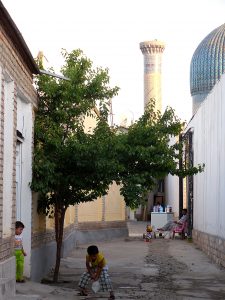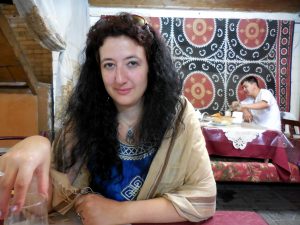Samarkand the Great; History and tips. Uzbekistan, Central Asia
Samarkand the Great; History and tips. Uzbekistan, Central Asia
Between the streets, towards evening.

I have always imagined Samarcanda as the beating heart of Central Asia, like an ancient veiled woman who hides the cracks of her adventures, but still full of esoteric charm. My expectations were not disappointed. Between the hidden mausoleums and the taciturne whitewashed alleys, the story tells; hidden among the turquoise letters of magnificent azulejos or between the folds of an Ikat dress worn by a shy elusive girl, the whispers of ancient astronomers and the steps of brave merchants are still soaked in the aura of the city.
Historical hints
Founded around 700 BC, called Afrasiab and later Marakanda, it was the capital of Sogdiana in the territory of Turan. Conquered in 329 BC by Alexander the Great, with the construction of roads has become a central hub in the Silk Road between the Mediterranean and China. Right here Alexander the Great decides to marry Rossane; always here that drunk kills his best friend Clito, guilty to remind him of being just a man.
Between the VI and XIII century AD the city flourished as an economic and cultural center of the territory, often under siege by Persians, Greeks and Arabs. In the XIIIth century, dominated by the Arab caliphate, Muslim culture took root in the area, strengthened by the Turkish Khaganate of the following centuries, when the city was called Sogd.
The dominion of the Mongols
In 1220, Genghis Khan arrived in this part of the world and conquered the city with red blood: after having conquered it, he led all the civilians out into the plain and beheaded them by building a pyramid with their heads as a sign of victory. Once again defeated by the Mongolian Barak Khan, Samarkand spends decades before recovering.
Tamerlane dinasty

From the Turkish-Mongolian tribe of the Barlas, Timur (the lame) or Tamerlane rises to power, declaring Samarkand the capital of the kingdom, making it one of the most prosperous and beautiful cities of the time. Between 1370 and 1499, Tamerlane and the Timurid dynasty built most of the architectural monuments that still make the city unique today. In the madras’ courtyards it was taught astronomy, religion, philosophy, medicine … Scholars and scientists are recruited in the capital, which becomes the most important cultural, political and economic center of all Central Asia.
Late Renaissance up to our days
With the rise of the Khanate of Bukhara, between the XVIth and the XXth centuries, the city of Samarkand became part of the princedom; with the invasion of Russian troops, in 1868 the city was included in the empire of the tsars.
Capital of the Uzbek SSR between 1925 and 1929, Samarkand continues to play an important role in the socio-cultural life of the country, even when the capital is transferred to Tashkent. After the collapse of the Soviet Union, the city, with its half a million inhabitants, continues to be a fundamental economic, political and cultural center for the country’s economy and industry.
How to reach Samarkand, Uzbekistan, Central Asia
In Uzbekistan, the railway lines work well and you can find travel information between the capital Tashkent and Samarkand here. Every morning at 8:00 a fast train leaves Tashkent and arrives at the destination in just two hours. The cost is around 15 euros. There are other options, but the routes become slower.
From the Autovokszal of Tashkent (bus station), five minutes from Sobir Rakhimov metro, buses depart for Samarkand; better to buy the ticket one day in advance, given the large number of travelers. There are also smaller buses (marshutka) and shared taxis that leave only when the seats are full. The cost of a shared taxi is about 7 dollars for 4 hours of travel. The bus costs around half, but it takes twice as long!
From Bhukara trains leave for Tashkent with a stop in Samarkand; travel information can be found here. From the station, buses usually leave in the morning; they are not frequent and even here they must be expected to fill up completely. The cost is around 3 euros. Double for shared taxis.
Where to eat

If you are adventurous and do not like tourist places, you can try the hot meals where the workers have a lunch break. You find one near the Mausoleum of Tamerlane, on the boulevard Unversitet Xiyoboni, immediately after an outdoor café. There I ate the best lagman of my life. If you want to stay close to Registon square, going up, you will see on the left a small road with low lights on the walls without billboards. You will see a certain external crowding: there they serve traditional cuisine with excellent grilled shashlik. You can dine among the locals, sitting on traditional Uzbek tables. They also serve fresh beer. The two-story restaurant with terrace facing Registon square is terrible.
For information on monuments, like Mausoleum Gur Emir, click here.

Pingback: Travel to Bukhara. Advises and historical background. Uzbekistan. | Erica Leoni